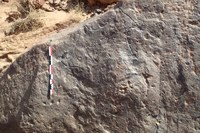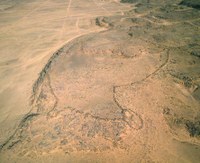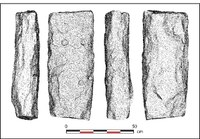Oldest architectural plans detail mysterious desert mega structures
Freiburg, May 19, 2023
The dimensions of desert dragons only become apparent from the air: at Jebel az-Zilliyat in Saudi Arabia, the true-to-scale engraving depicts nearby desert dragons. Source: Oliver Barge, CNRS
Although human constructions have modified natural spaces for millennia, few plans or maps predate the period of the literate civilizations of Mesopotamia and Ancient Egypt. Researchers from the French research organisation "Centre national de la recherche scientifique" (CNRS), together with Prof. Dr. Frank Preusser from the University of Freiburg, have now been able to identify engravings in Jordan and Saudi Arabia as the oldest known true-to-scale construction plans in human history. The 8,000 to 9,000-year-old engravings depict so-called desert dragons – kilometre long prehistoric megastructures used to trap animals. "Conclusions can be drawn from the findings about the people of the time. The ability to transfer a large space to a small, two-dimensional plan represents a milestone in intelligent behaviour," explains Preusser. The results, which were published in mid-May in the scientific journal PLOS ONE, should help to understand how desert dragons were conceived and built.
Scale plans of desert dragons discovered in Jordan and Saudi Arabia
Both finds are representations of nearby desert dragons engraved with stone tools. First sighted from aircrafts in the 1920s, desert dragons, up to five kilometres long, consist of stone walls that converge in a complex bounded by pits. As archaeologists have been able to determine in recent years, they were used for large-scale trapping of wild animals. In Jordan, there are eight desert dragons in the area of Jibal al-Khasabiyeh. There, the researchers found a depiction engraved in stone that measures 80 by 32 cm, its age is about 9,000 years. At Jebel az-Zilliyat in Saudi Arabia, two visible pairs of dragons are found three and a half kilometres apart. Here, too, a scaled engraving dating back about 8,000 years was discovered with a total length of 382 cm and a width of 235 cm.
Plans of large structures have so far only been attested by rough representations, in stark contrast to the precision of the engravings of al-Khashabiyeh and az-Zilliyat. The question of their exact use and how they were implemented, especially due to the difficulty of grasping the entire complex from the ground, remains for the time being the secret of the people by whom they were created.
Overview of facts:
- Crassard R., Abu-Azizeh W., Barge O., Brochier J.É., Preusser F., Seba H., Kiouche A.E., Régagnon E., Sánchez Priego J.A., Almalki T., Tarawneh M., 2023. The oldest plans to scale of humanmade mega-structures. PLOS ONE 18(5): e0277927. https://doi.org/10.1371/journal.pone.0277927
- Frank Preusser is Professor for Sedimentology at the Institute for Earth and Environmental Sciences, Faculty of Environment and Natural Resources, at the University of Freiburg. His research emphasis is on the response of terrestrial sedimentary systems to climate change and human impact during the Quaternary. In particular, he is investigating the erosion and depositional history of the Alps and environmental developments on the Arabian Peninsula. A special interest is on geochronology, specifically luminescence dating.
- The South-Eastern Badia Archaeological Project (SEBAP; research at Jibal al-Khashabiyeh) is funded by grants from the French Ministry of Foreign Affairs, Al-Hussein Bin Talal University (project No. 164/2016) and the CNRS National Institute for Humanities and Social Sciences. The GLOBALKITES project (research at Jebel az-Zilliyat) was funded by a French National Research Agency grant ANR-12-JSH3-0004-01 (RC). The Dumat al-Jandal archaeological project (research at Jebel az-Zilliyat) was funded by grants from the Saudi Heritage Commission, the French and Italian Ministries of Foreign Affairs, CNRS UMR-8167 Orient & Méditerranée, the University L’Orientale of Naples (Guillaume Charloux and Romolo Loreto).
Press images for download
Contact:
University and Science Communication
University of Freiburg
Tel.: 0761/203-4302
E-mail: kommunikation@zv.uni-freiburg.de





